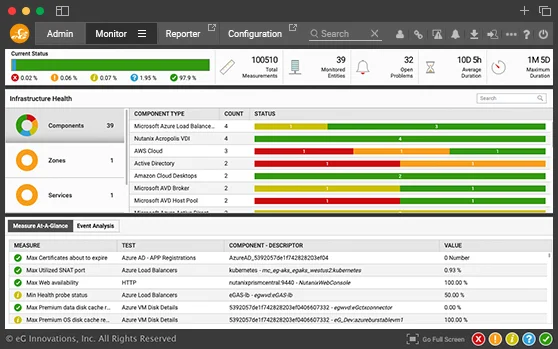Observability for Modern IT with
eG Enterprise v7.2
From virtual desktops to physical endpoints, from web applications to legacy apps, from physical machines to containers in the cloud, monitor all modern and legacy applications from one console, with AIOps technologies embedded in eG Enterprise.
Free TrialModern IT: Changing Technologies
and Operating Models
The last few years have forced dramatic changes in the IT landscape. Digitization of customer, supply-chain interactions and internal operations has accelerated by three to four years. The share of digital products in a company’s portfolio has accelerated by seven years.
What this has meant is that organizations across verticals and sizes are relying on IT even more than before. Modern IT infrastructures are being designed to support hybrid workstyles, adopting digital workspaces on-prem and in the cloud. Unified communication technologies like Microsoft Teams and Zoom are commonplace today. Migration to the cloud is happening at a fast pace and applications are being designed using container technologies.

At the same time, IT operations technologies, processes and models are also changing. Reliance on a few experts is a thing of the past. Organizations are seeking tools and processes that make IT management repeatable and predictable. There is increased emphasis on making technologies accessible from anywhere, looking at automation of routine tasks, and a focus on monitoring security and cost control, especially as the adoption of cloud services grows.
Observability for Modern IT
Modern IT necessitates specialized ways for monitoring these new technologies. After all, failures in a digital workspace or a unified communications environment may happen in different ways than in a traditional IT infrastructure.
At the same time, monitoring tools have to be augmented with AIOps technologies for detecting anomalies, discovering inter-dependencies, identifying the root-cause of problems, etc. This is where observability comes in. Observability tools benefit different stakeholders in an organization and provide insights specific to each stakeholder’s needs.


eG Enterprise v7.2 incorporates new monitoring, AIOps, automation and cost analysis features that make it a complete observability solution for modern IT. Enhancements in this version cover all four core areas of focus for eG Enterprise: digital workspaces, application performance, monitoring of enterprise applications and unified, end-to-end monitoring. Built-in monitoring for over 600 different application and infrastructure components, 60,000 unique health checks and over 50,000 unique metrics make eG Enterprise one of the most comprehensive solutions in the industry. With eG Enterprise, organizations can embrace secure, modern, and efficient best practices and implement them through their digital transformation journey.
New Features in
eG Enterprise v7.2
Check eG Enterprise full version history
Enhanced Multi-Vendor Digital Workspace Monitoring
eG Enterprise now provides the most comprehensive range of monitoring, diagnosis and reporting capabilities for any digital workspace. Whether you are using one or more of Citrix, Omnissa Horizon, AWS AppStream 2.0, AWS WorkSpaces, Microsoft RDS, or Microsoft Azure Virtual Desktops, we have you covered! Get a consistent set of dashboards and reports across these diverse technologies. Key enhancements in this release include:
I'm impressed with what eG Enterprise has to offer in end-to-end monitoring for Azure Virtual Desktop. The auto discovery capabilities, including out of the box thresholds, allow for easy and fast configuration. Getting detailed insights in logon duration, application launch times and the perceived end user experience is great. The ability to gather load simulation tests details using a synthetic user is super helpful and the way they are displayed in the console is great. ![]()
Application Performance Monitoring Made More Effective
Improvements in eG Enterprise v7.2 are aimed at making APM easier to deploy, to offer deeper/better insights into application performance and to support a wider range of technologies.
Expanding Coverage for End-to-End, Unified Monitoring
Enhancements in this area focus on improved breadth of coverage. Key additions are indicate below:














